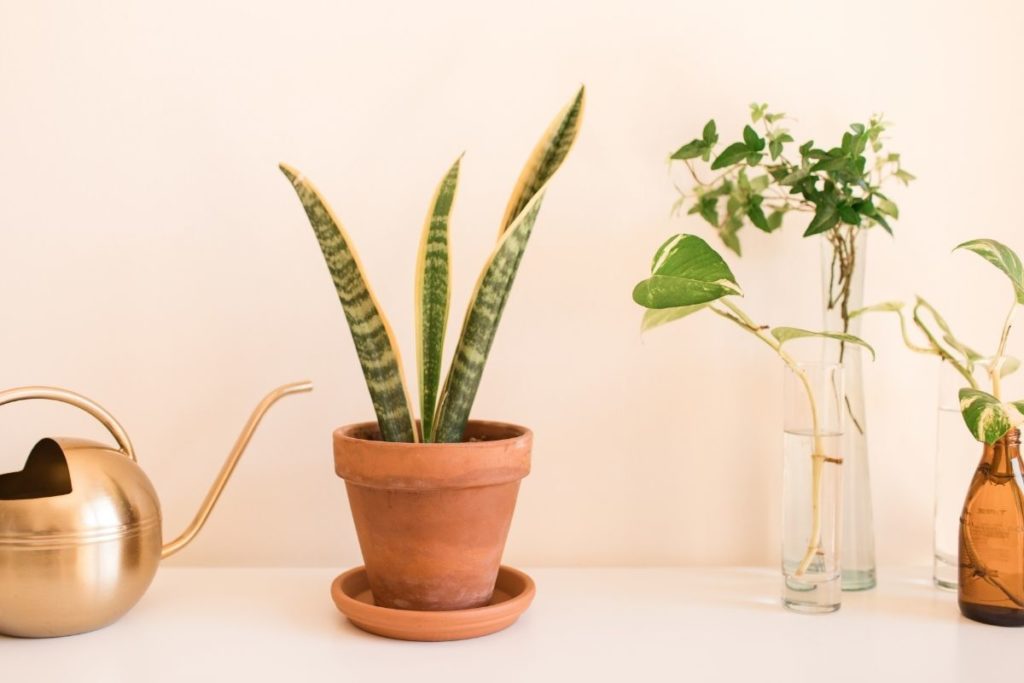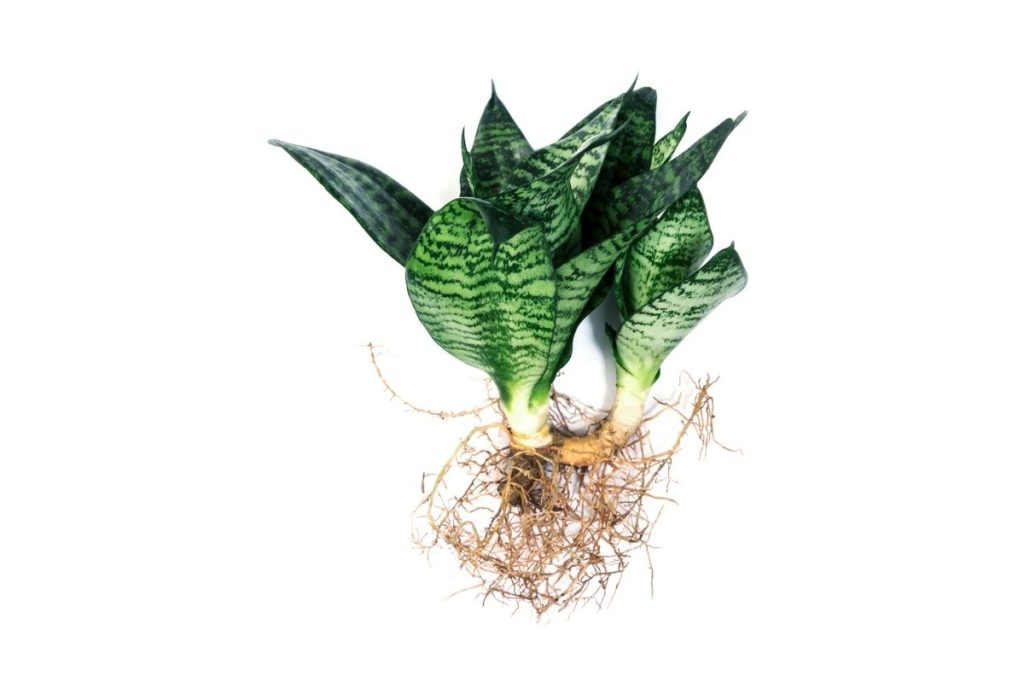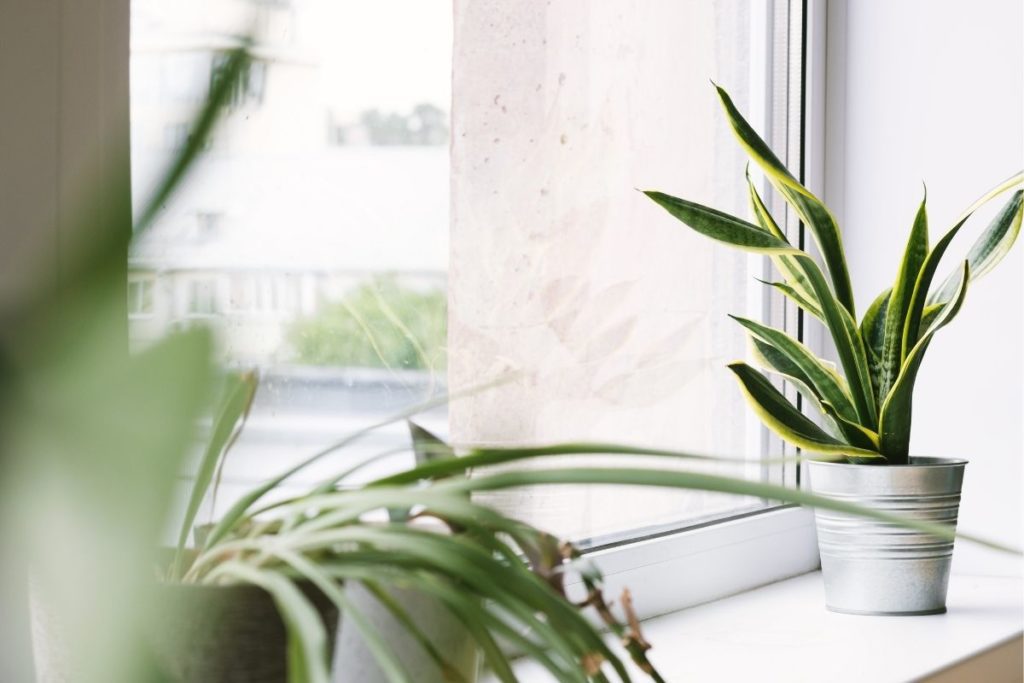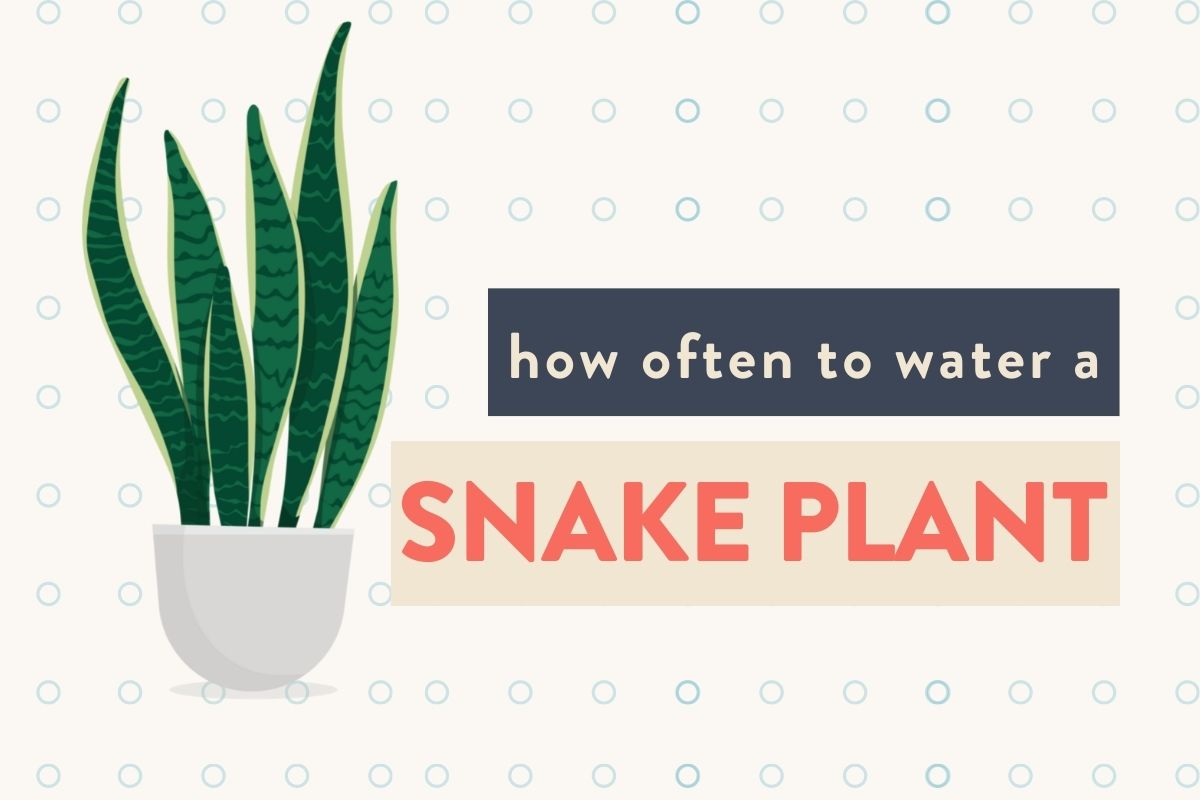Key takeaways
- Snake plants are drought-tolerant and can survive with minimal water.
- Overwatering can lead to root rot and other issues, so it’s important to let the soil dry out between watering.
- How often you should water your snake plant depends on various factors such as the temperature and humidity levels, pot size, and soil type.
- In general, it’s recommended to water snake plants every 2-6 weeks, depending on the conditions.
- The best way to check if your snake plant needs water is to stick your finger about an inch into the soil. If it feels dry, it’s time to water.
- When watering, give the plant a good soaking and allow excess water to drain out of the pot.
The snake plant, also known as the viper’s bowstring hemp plant, is a hardy plant native to southern Africa that can tolerate many environmental conditions. (good news, plant newbies!)
They are especially prized as great house plants due to their resilient nature and not being picky about sunlight or water. With their upright, sword-like foliage, (also called mother-in-law’s tongue) this handsome plant will add style to any room in your home. They are a great addition to your indoor or outdoor plant collection.
With the various types of snake plants, from the long leaves of the cylindrical snake plant to the short leaves of the bird’s nest snake plant, there is sure to be a variety pleasing to your home.
This article will outline how to provide snake plant care, and how to avoid common watering problems so that you may enjoy your plants for years to come.
How often to water a snake plant
The snake plant is extremely drought-tolerant, unlike other indoor plants. Due to this trait, the snake plant can be watered every 1-2 weeks. If you forget to water, don’t fret! In times when water is scarce, the snake plant will be just fine and can go without water for two weeks or even longer. They tend to like to be completely dry between waterings.
However, it is important to pay attention to your snake plant and know when and how to water to avoid any watering mistakes. It is easy to care for a snake plant if you keep these tips in mind.

Things that impact your snake plant watering schedule
The snake plant will often respond to the outside environment, whether it is grown outdoors or kept indoors. The outside seasons, including the common growing season of spring and the winter months, will affect your plant’s natural rhythm.
How much light the plant receives, indoor temperature and humidity of your home, physical location of the plant, soil type, and the size of the plant and pot size will all also affect the watering schedule in different ways.
When providing care for a snake plant, it is important to consider all environmental factors and how to respond to them.
Temperature and humidity
Temperature and humidity often go hand-in-hand when it comes to snake plant care. If the air surrounding your snake plant is too dry, the plant will begin to suffer. However, they are tropical and desert-dwelling plants and can be susceptible to mold if the air is too humid. This is not normally an issue as this plant is known for its hardy nature.
Where this can be a problem is in homes that have central air conditioner or heat. Both of these tend to dry the air or exaggerate humidity levels. When the snake plant is watered correctly, it will fare better against these changing levels, even if they don’t match what the plant usually requires. The main thing to understand is that when the air is more humid, the less the snake plant should be watered.
Alternatively, if the air is dry or heating is higher, especially in the winter months, it will likely need to be watered more often. Placing the snake plant in direct sunlight will also increase the temperature, and although the snake plant isn’t particularly choosy about the light levels, low light may be more ideal.
Type of soil
Soil is also an important factor in watering and the snake plant’s overall health. Any bag of regular potting soil from Lowe’s is not going to cut it if you want a thriving plant. However, with so many types of potting soil on the market, how do you know what to choose?
Many potting mixes are designed to retain water for as long as possible, so the manufacturer includes peat or coconut husk in the mix in order to accomplish this. These two products act as blotting paper, which soaks up water and then releases it slowly as the surrounding soil dries out.
For most indoor plants, this works well. In the case of the snake plant, this type of water-retaining potting mix is not ideal. Instead, opt for a mix that retains nutrients, but releases moisture more quickly.
Due to the native desert location of the snake plant, a standard cactus mix will be the best option.
Obviously, in this case with cactus soil, the snake plant will need to be watered more often as the soil does not retain moisture. If you choose to go with more water-retentive soil, less watering will be required.
Size of the plant respective to the pot
The size of your plant and pot size is important factor in how often to water snake plants. The bigger your snake plant’s pot that is, the more water it will require. The larger leaves are going to transpire more, and as a result, the plant will need more frequent watering than when it was smaller.
Pot type is also important to consider. A glazed or plastic pot will not allow water to evaporate through the sides, and therefore, hold water better. A more porous pot, such as a terracotta pot, will allow some water to be lost as it will seep through and evaporate through the walls of the pot itself.
The size also matters, if the pot is much larger than the root ball, there will be more space for soil and will hold more moisture when wet. This runs the risk of overwatering. Snake plants tend to hate having “wet feet” so a properly sized pot without too much extra space is ideal.
How much water does a snake plant need?
So, you may be asking how much water does a snake plant really need? To answer this, you must also know how to water.
There are two very specific methods on how to correctly water your plants.
The first way is to pour water on the surface of the soil using a watering can or jug. Stand the pot in a sink or basin and keep pouring water until you see it drain from the holes in the bottom of the pot. You can also use a plant saucer to catch excess water. Be careful not to water the beautiful cylindrical leaves and focus only on the soil.
The second way is to place the pot in a plant saucer or basin of water, and the water will eventually soak up by the process of osmosis. Be sure to drain the excess water from the saucer or basin to avoid problems like mold.
When watering is different than normal
Normally, when you repot a plant, it must be watered once transferred to its new home. For a snake plant, this is not necessary. Potting soil is almost always damp, and because the snake plant likes to dry out between waterings, you do not need to water it as soon as it is replanted. Instead, waiting three or four days until the soil looks dry will be ideal.
The snake plant is a desert-dweller, so allowing it to dry will help the plant thrive when replanted.
There is another instance when the normal watering rules of the snake plant can be abandoned, and that is in the case of a propagated snake plant. This is the process in which you take a cutting in order to grow a new plant from the “parent” plant. Once cut, the cutting should be placed in a glass of water for several weeks until a strong root system is formed.
New roots should be at least an inch long before potting the new plant. After this goal has been met, each cutting can be placed in a small individual pot or you can combine three or four cuttings in a larger pot.

Keep in mind the watering requirements for size and potting type when planning how to plant your new cuttings. In this case, do not allow the plant to completely dry out between waterings. Instead, you want to keep the soil slightly moist so roots can develop and grow deeper into the soil.
When the root system is well established, you may default to the regular watering method above.
Signs that your snake plant is overwatered
Unfortunately, the signs of both overwatering and under watering a snake plant are similar. An overwatered plant can develop root rot.
The fungi that cause root rot thrive in wet soil and even infect nearby plants if they share the same space, so you want to fix your snake plant’s root rot right away when you notice signs that it’s set in. The soil moisture and level of your plants should be monitored closely.
Fortunately, there are some early signs to look out for in an overwatered snake plant:
- Young and old leaves fall over at the same time;
- A rotten smell or roots disappear due to lack of oxygen;
- Water stagnates in the pot after watering;
- Mold appears on the surface of the soil;
- Leaves turn yellow or brown and have a mushy texture;
- Healthy white roots change in color to brown.
Signs that your snake plant is underwatered
Similar to overwatering, underwatering the snake plant can quickly lead to plant death if not corrected. Although the snake plant is known for not needing a lot of water, it will suffer if left in direct sun or going without water for too long.
Here are the signs to look for to tell if your snake plant may be underwatered, pay close attention to the plant’s tall leaves:
- Wrinkled leaves;
- Leaves have brown tips;
- Leaves begin to turn brown and crunchy;
- Leaves fall off;
- Leaves curl up.
How do you know when your snake plant needs water?
To avoid problems such as overwatering or underwatering, it is important to be able to tell if your snake plant needs water. Luckily, there are a few ways to tell by using your senses if your snake plant is in need of water.
If the soil feels dry and crumbly, you likely need to water the plant. Push your finger a bit into the soil, if it feels damp, the plant is okay. If it still feels dry, water. This is called the “touch test”.
A device called a soil probe can also be used to test the moisture level of your soil more accurately. You can also look at the soil color to tell. Damp soil is usually darker in color than dry soil. If it appears lighter, the plant may need water.
Also pay attention to the plant’s leaves, as they will change in response to the watering situation as well. The leaves should stay a beautiful dark green color in a healthy plant.
When your snake plant needs more water
Certain conditions will require you to water your snake plant more. It is important to pay attention to certain environmental factors in your home and within your garden space to know when watering should be closely monitored or more water should be given.
- Plant is placed in direct light: Your plant will need to be monitored and watered more often if it is in direct sunlight, or near an artificial light source, which is drying to the plant. Snake plants do not need much light to thrive, and can grow fine in low light.
- There is active plant growth: When your young plant is actively growing, it will consume more water. This is the critical time to keep the soil moist at all times rather than letting it dry out.
- If the plant grows in dry air (central heat): Central heating can be drying to a snake plant. If you live in a cold environment that requires you to use heating, be sure to monitor your plants and continue watering your snake plant if it looks dry.
- If the roots completely fill the pot: If the roots completely fill the pot or the pot is on the small side, there is less space for soil and it will become drier faster. Until you can work on repotting snake plants, provide more water.
When your snake plant needs less water
There are other times when your snake plant may need less water. Keeping in mind they like to dry out between watering and do not like having “wet feet” check these conditions and water snake plants accordingly.
- Plants are grown in a cool room: Just as heating dries out a snake plant, a plant grown in a cooler room will not dry out as quickly and can go longer between watering.
- After transplanting: As mentioned above, a newly transplanted snake plant will not need further watering as the soil will likely already be damp.
- Leaves show signs of overwatering: If your snake plant is showing signs of overwatering, such as yellow or mushy leaves, you may need to hold off on water and allow the snake plant’s soil to dry out. You will need to move it to bright light or more sunlight to aid in drying or replanting the snake plant in fresh soil and a new pot.
Soil is damp or dark in color: When determining if your snake plant needs water, perform the touch test and look closely at the soil. If it appears dark or feels damp to the touch, the snake plant does not need water at that time. Be sure to push your finger down into the soil to check for moisture below the surface. More water could result in an overwatering situation and waterlog your plant!

What to know about watering snake plants
Most snake plants do not require a lot of watering, so it is important to pay attention to the plant and monitor both the plant itself and the soil to determine frequency of watering. Be sure to check for the signs of over or under watering, such as drooping leaves, and monitor the moisture levels of the soil using the methods described.
Snake plant care is normally very easy as long as you are aware of the signs and how to respond to them.
They like to dry out in between watering
As mentioned above, the snake plant does not like having “wet feet”. Your snake plants will appreciate the opportunity for the plant’s roots to soak up the water and dry out a little before watering again.
It will be a good idea to monitor your plant and water every 2-3 days, or longer if the soil still appears wet after a few days. Again, this will likely depend on the type of garden soil you have used.
Don’t water the leaves, just the soil
When you water your snake plants, it is important to focus on watering the soil only. Your snake plant absorbs water, and with it, nutrients from fertilizer and soil, primarily through its roots. Even if you research and buy the best fertilizer for your snake plant, it won’t have the desired effect unless you apply it to the soil (this is sometimes called ‘soil drench’).
While most plants can tolerate getting their leaves or flowers wet, the snake plant is not one of them. Getting the plant’s leaves wet can lead to rotting and potentially kill your snake plant.
Make sure there is good drainage
Especially for indoor plants, make sure your pot has good drainage holes in the bottom. Indoor plants are pot bound and must have good drainage that an outside garden allows naturally. These are the tiny holes that allow excess water to seep through so it does not sit at the bottom of the plant’s pot.
As the snake plant is easily prone to root rot, it is important to use a free-draining potting mix. Cactus or an African violet soil mixture will allow for proper drainage and drying between waterings.
You will want to avoid most common types of potting mix, as they are often developed to retain as much water as possible. Also remember to allow the excess water to drain out or dump the plant saucer if extra water has collected. If your soil gets waterlogged, it may be best to change to fresh soil and repot your plant.
Read more about snake plants
- How Often To Water Dracaena (Including Snake Plants)
- How To Save An Overwatered Snake Plant
- Growing Dracaena Marginata: Care Tips
- Best Soil For Snake Plants That Will Keep Them Happy
- Snake Plant Care: how to keep them happy
- How To Choose The Best Snake Plant Fertilizer
- Snake plant root rot (and how to save it)
- Tags:
- Easy-Care Plants
- plant care




